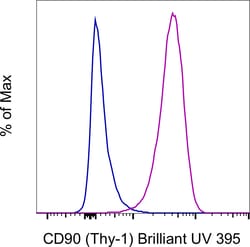Learn More
Invitrogen™ CD90 (Thy-1) Monoclonal Antibody (eBio5E10 (5E10)), Brilliant Ultra Violet™ 395, eBioscience™, Invitrogen™


Mouse Monoclonal Antibody
Supplier: Invitrogen™ 363090942

Description
The eBio5E10 monoclonal antibody reacts with human CD90, also known as Thy-1 (thymus cell antigen-1). CD90 is a 25-35 kD receptor expressed on thymocytes, CD34+ prothymocytes, hematopoietic stem cells, neurons, a small subset of human fetal liver cells, cord blood cells, and bone marrow cells. CD90 is expressed on a subset of immature, CD34+ cells and a distinct subset of mature CD34- cells that are CD3+CD4+. The CD90+CD34+ population is enriched for cells capable of long-term culture. CD90 is involved in regulation of adhesion and signal transduction by T cells. Applications Reported: This eBio5E10 (5E10) antibody has been reported for use in flow cytometric analysis. Applications Tested: This eBio5E10 (5E10) antibody has been pre-diluted and tested by flow cytometric analysis of HEL cells. This may be used at 5 μL (0.25 μg) per test Brilliant Ultra Violet 395 (BUV395) is a dye that emits at 395 nm and is intended for use on cytometers equipped with an Ultraviolet (355 nm) laser. Please make sure that your instrument is capable of detecting this fluorochrome. When using two or more Super Bright, Brilliant Violet, Brilliant Ultra Violet, or other polymer dye-conjugated antibodies in a staining panel, it is recommended to use Super Bright Complete Staining Buffer (SB-4401-42) or Brilliant Stain Buffer (00-4409-75) to minimize any non-specific polymer interactions. Excitation: 350 nm; Emission: 395 nm; Laser: Ultraviolet Laser.
CD90 (Thy 1) antigen is a GPI linked glycoprotein member of the Immunoglobulin super family. CD90 is expressed in murine T cells, thymocytes, neural cells, Kupffer's cells and fibroblasts. CD90 may play a role in cell-cell or cell-ligand interactions during synaptogenesis and other events in the brain. CD90 can be used as a marker for a variety of stem cells and for the axonal processes of mature neurons. Structural study of CD90 led to the foundation of the Immunoglobulin superfamily, of which it is the smallest member, and led to the first biochemical description and characterization of a vertebrate GPI anchor. Diseases associated with CD90 dysfunction include nasopharyngeal carcinoma and thymoma.
Specifications
| CD90 (Thy-1) | |
| Monoclonal | |
| 5 μL/Test | |
| PBS with BSA and 0.09% sodium azide; pH 7.2 | |
| P04216 | |
| Thy1 | |
| Affinity chromatography | |
| RUO | |
| 7070 | |
| 4°C, store in dark, DO NOT FREEZE! | |
| Liquid |
| Flow Cytometry | |
| eBio5E10 (5E10) | |
| Brilliant Ultraviolet 395 | |
| Thy1 | |
| CD7; CD90; CDw90; FLJ33325; membrane glycoprotein; T25; Thy 1.2; THY1; Thy-1; Thy-1 antigen; Thy-1 cell surface antigen; thy-1 glycoprotein; thy-1 membrane glycoprotein; Thy-1 protein; Thy-1 T-cell antigen; Thy1.1; Thy1.2; Thy-1.2; thymus cell antigen 1, theta; Thymus cell surface antigen | |
| Mouse | |
| 100 Tests | |
| Primary | |
| Human | |
| Antibody | |
| IgG1 κ |
The Fisher Scientific Encompass Program offers items which are not part of our distribution portfolio. These products typically do not have pictures or detailed descriptions. However, we are committed to improving your shopping experience. Please use the form below to provide feedback related to the content on this product.
